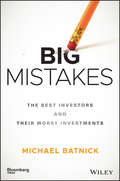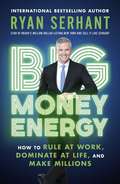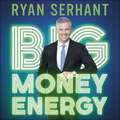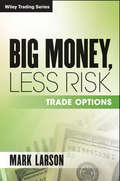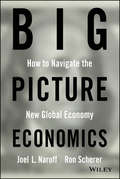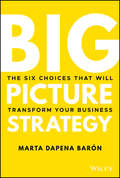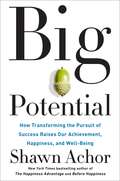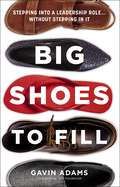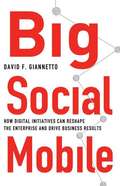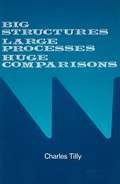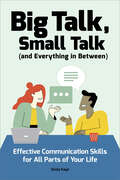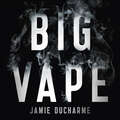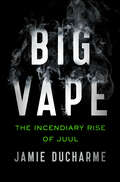- Table View
- List View
Big Mistakes: The Best Investors and Their Worst Investments (Bloomberg)
by Michael BatnickA Must-Read for Any Investor Looking to Maximize Their Chances of Success Big Mistakes: The Best Investors and Their Worst Investments explores the ways in which the biggest names have failed, and reveals the lessons learned that shaped more successful strategies going forward. Investing can be a rollercoaster of highs and lows, and the investors detailed here show just how low it can go; stories from Warren Buffet, Bill Ackman, Chris Sacca, Jack Bogle, Mark Twain, John Maynard Keynes, and many more illustrate the simple but overlooked concept that investing is really hard, whether you're managing a few thousand dollars or a few billion, failures and losses are part of the game. Much more than just anecdotal diversion, these stories set the basis for the book's critical focus: learning from mistakes. These investors all recovered from their missteps, and moved forward armed with a wealth of knowledge than can only come from experience. Lessons learned through failure carry a weight that no textbook can convey, and in the case of these legendary investors, informed a set of skills and strategy that propelled them to the top. Research-heavy and grounded in realism, this book is a must-read for any investor looking to maximize their chances of success. Learn the most common ways even successful investors fail Learn from the mistakes of the greats to avoid losing ground Anticipate challenges and obstacles, and develop an advance plan Exercise caution when warranted, and only take the smart risks While learning from your mistakes is always a valuable experience, learning from the mistakes of others gives you the benefit of wisdom without the consequences of experience. Big Mistakes: The Best Investors and Their Worst Investments provides an incomparable, invaluable resource for investors of all stripes.
Big Money Energy: How to Rule at Work, Dominate at Life, and Make Millions
by Ryan SerhantHOW TO DOMINATE, MAKE MILLIONS, AND GET ANYTHING YOU WANT "Serhant shows us it's not enough to just have goals, but to chase our dreams with a verve and joyous energy. Highly practical and infectiously fun." Mark Manson, NYT bestselling author of The Subtle Art of Not Giving a F*ck and Everything is F*cked"In Big Money Energy, Ryan Serhant shows readers that when positive energy is mixed with self-confidence and topped off with a heavy dose of hustle. . . anything can be achieved." Sophia Amoruso, NYT bestselling author of #GIRLBOSS Big Money Energy is the feeling you get when you encounter someone who is massively succeeding at life. They're the ultimate picture of self-confidence. There's no bravado, no bragging - they know they have BME and so does everyone else. You get Big Money Energy by being 100% committed to making your vision a reality... and that vision has to be BIG. Ten years ago, Ryan Serhant, billion dollar broker and co-star of Million Dollar Listing New York was living paycheque-to-paycheque and didn't even own a suit. He realized that while he couldn't change his circumstances or the balance of his bank account, there was one thing he could change - his energy. The energy you give off impacts every area of your life, from how much money you earn and how much power you have, to who you socialize with and the jobs you get. Determined to leave his low-rent lifestyle behind forever, Serhant took life-changing steps that resulted in his getting cast on television and doubling his income every year for the next decade. He is now the CEO and Founder of SERHANT., a multi-dimensional property brokerage and media company, and averages a billion dollars in sales every year. Big Money Energy shows you how he tapped into his Big Money Energy to crush his goals and achieve huge success, earning his first million before he turned thirty. Whether you're a self-made entrepreneur, a corporate executive or barista, Serhant will teach you how to climb the ladder to success better and faster than anyone else. If you want Big Money Energy, this is your blueprint. This book is an inspirational, lively guide for anyone who is ambitious enough to dream big and is committed to doing whatever it takes to conquer their goals.
Big Money Energy: How to Rule at Work, Dominate at Life, and Make Millions
by Ryan SerhantRestructure your approach to money and reap the rewards in business and life with this inspiring, life-changing guide from the international bestselling author and star of Bravo's Million Dollar Listing and Sell It Like Serhant. Big Money Energy is the feeling you get when you encounter someone who is massively succeeding at life. They're the ultimate picture of self-confidence. There's no bravado, no bragging - they know they have BME and so does everyone else. You get Big Money Energy by being 100% committed to making your vision a reality... and that vision has to be BIG. Ten years ago, Ryan Serhant, billion dollar broker and co-star of Million Dollar Listing New York was living paycheque-to-paycheque and didn't even own a suit. He realized that while he couldn't change his circumstances or the balance of his bank account, there was one thing he could change - his energy. The energy you give off impacts every area of your life, from how much money you earn and how much power you have, to who you socialize with and the jobs you get. Determined to leave his low-rent lifestyle behind forever, Serhant took life-changing steps that resulted in his getting cast on television and doubling his income every year for the next decade. He is now the CEO and Founder of SERHANT., a multi-dimensional property agency and media company, and averages a billion dollars in sales every year. Big Money Energy show you how he tapped into his Big Money Energy to crush his goals and achieve huge success, earning his first million before he turned thirty. Whether you're a self-made entrepreneur, a corporate executive or barista, Serhant will teach you how to climb the ladder to success better and faster than anyone else. If you want Big Money Energy, this is your blueprint. This book is an inspirational, lively guide for anyone who is ambitious enough to dream big and is committed to doing whatever it takes to conquer them.(P)2021 Hachette Audio
Big Money Energy: How to Rule at Work, Dominate at Life, and Make Millions
by Ryan SerhantNational bestselling author and star of Bravo's Million Dollar Listing and Sell It Like Serhant shows readers how to restructure their approach to money so they can achieve success in business and life.Big Money Energy is the feeling you get when you encounter someone who is massively succeeding at life. They're the ultimate picture of self-confidence. There's no bravado, no bragging—they know they have BME and so does everyone else. You get Big Money Energy by being 100% committed to making your vision a reality . . . and that vision has to be BIG.Ten years ago, Ryan Serhant, billion dollar broker and costar of Million Dollar Listing New York was living paycheck-to-paycheck and didn't even own a suit. Serhant realized that while he couldn't change his circumstances or the balance of his bank account, there was one thing he could change—his energy. The energy you give off impacts every area of your life, from how much money you earn and how much power you have, to who you socialize with and the jobs you get.Determined to leave his low-rent lifestyle behind forever, Serhant took life-changing steps that resulted in his getting cast on television, graduating to seven-figure sales, and doubling his income every year for the next decade. Serhant is now the CEO and Founder of SERHANT., a multi-dimensional real estate brokerage and media company, and averages a billion dollars in sales every year.In Big Money Energy, Serhant will show readers how he tapped into his Big Money Energy to crush his goals and achieve huge success, earning his first million before he turned thirty. Whether you're a self-made entrepreneur, a corporate executive or barista, Serhant will teach you how to climb the ladder to success better and faster than anyone else.If you want Big Money Energy, this is your blueprint. This book is an inspirational, lively guide for anyone who is ambitious enough to dream big and is committed to doing whatever it takes to conquer them.
Big Money Thinks Small: Biases, Blind Spots, and Smarter Investing
by Joel TillinghastMarket mistakes to avoid: &“Written for investors at all levels…[a] practical, no-nonsense guide.&”—Publishers Weekly One of Money Week&’s Five Best Books of the Year Investors are tempted daily by misleading or incomplete information. They may make a lucky bet, realize a sizable profit, and find themselves full of confidence. Their next high-stakes gamble might backfire, not only hitting them in the balance sheet but also taking a mental and emotional toll. Even veteran investors can be caught off guard: a news item may suddenly cause havoc for an industry they&’ve invested in; crowd mentality among fellow investors may skew the market; a CEO may turn out to be unprepared to effectively guide a company. How can one stay focused in such a volatile world? If you can&’t trust your past successes to plan and predict, how can you avoid risky situations in the future? Patience and methodical planning will pay far greater dividends than flashy investments. In Big Money Thinks Small, veteran fund manager Joel Tillinghast shows investors how to avoid making these mistakes. He offers a set of simple but crucial steps to successful investing, including: · Know yourself, how you arrive at decisions, and how you might be susceptible to self-deception · Make decisions based on your own expertise, and do not invest in what you don&’t understand · Select only trustworthy and capable colleagues and collaborators · Learn how to identify and avoid investments with inherent flaws · Always search for bargains, and never forget that the first responsibility of an investor is to identify mispriced stocks
Big Money Thinks Small: Biases, Blind Spots, and Smarter Investing (Columbia Business School Publishing)
by Joel TillinghastInvestors are tempted daily by misleading or incomplete information. They may make a lucky bet, realize a sizable profit, and find themselves full of confidence. Their next high-stakes gamble might backfire, not only hitting them in the balance sheet but also taking a mental and emotional toll. Even veteran investors can be caught off guard: a news item may suddenly cause havoc for an industry they’ve invested in; crowd mentality among fellow investors may skew the market; a CEO may turn out to be unprepared to effectively guide a company. How can one stay focused in such a volatile profession? If you can’t trust your past successes to plan and predict, how can you avoid risky situations in the future?In Big Money Thinks Small, veteran fund manager Joel Tillinghast shows investors how to avoid making these mistakes. He offers a set of simple but crucial steps to successful investing, including:· Know yourself, how you arrive at decisions, and how you might be susceptible to self-deception.· Make decisions based on your own expertise, and do not invest in what you don’t understand.· Select only trustworthy and capable colleagues and collaborators.· Learn how to identify and avoid investments with inherent flaws.· Always search for bargains, and never forget that the first responsibility of an investor is to identify mispriced stocks. Patience and methodical planning will pay far greater dividends than flashy investments. Tillinghast teaches readers how to learn from their mistakes—and his own, giving investors the tools to ask the right questions in any situation and to think objectively and generatively about portfolio management.
Big Money, Less Risk
by Mark LarsonBig Money, Less Risk: Trade Options will put the income boosting power of strategies like writing covered calls, selling naked put options, and placing vertical spread trades or iron condors in your hands. Mark Larson has become one of the most sought after trading educators because of his ability to make once elusive investment approaches accessible to every trader.Success in the stock market is determined by consistently making money every month, not closing your eyes and hoping you can afford to retire. With this book, Larson divulges the secrets to making your money work for you instead of having to work for your money.Ever dream about making 30% in one month?Big Money, Less Risk: Trade Options will put the income boosting power of strategies like writing covered calls, selling naked put options, and placing vertical spread trades or iron condors in your hands. Mark Larson has become one of the most sought after trading educators because of his ability to make once elusive investment approaches accessible to every trader.Success in the stock market is determined by consistently making money every month, not closing your eyes and hoping you can afford to retire. With this book, Larson divulges the secrets to making your money work for you instead of having to work for your money.Inside you'll learn:How to repeatedly make money when the market goes up or down.Investment strategies that allow for huge returns with the use of very little money.How to purchase good stocks at discount prices.How to make significant returns even if you are wrong on the trade.Larson will alo cover the importance of option pricing, implied volatility, the Greeks such as delta, theta, and gamma, and the probability of your option expiring profitable. Most important, you will get, in plain English, some of his favorite technical indicators and the key to how they will form the basis of your options trading success.
Big Money: What It Is, How We Use It, and Why Our Choices Matter
by Rebecca DonnellyIn this basic introduction to money, readers learn about various economic models throughout history with compelling illustrations and probing questions that explore the real world circumstances surrounding spending, selling, and saving.Big Money aims to explain economic principles in a way that combines the weird and the meaningful, like Planet Money for kids. Organized in seven chapters, each posing a general question and answering it through real-world examples, this book explores the consequences of our everyday economic choices by connecting the dots between young consumers and the larger economic and social systems around them.
Big Picture Economics
by Joel Naroff Ron SchererNavigate the economy with this insightful new bookThe world is awash with economic information. Governments release reports. Pundits give their interpretation on television. And the stock market may go its own way, confusing everyone. How can you better understand what it means for you?Big Picture Economics, a new book by award-winning columnist and futurist Joel Naroff and veteran journalist Ron Scherer, says the thread that ties everything together is "context."The authors show how consumers, business, the Federal Reserve, and government take into account what's going on around them to make critical decisions like buying new products, building new factories, changing interest rates, or setting budget goals. The book provides a clear roadmap to understanding the whole story behind the global economy.Big Picture Economics helps readers understand how context impacts decisions and decision makers.- The Federal Reserve and Congress in formulating economic policy- Consumers in a shopper nation and what makes us buy or not buy- Corporations making decisions on whether to build new factories and buy other companies- The federal budget that must deal with complex issues, including the reduction of health care spending- A simple test for tax cuts or increases: will they help the economy grow?- Where to produce and where to sell in a global economy that is more like a Mobius strip than a flat world- International events that can ripple through the economy and ultimately affect workers in the Midwest- Technology, such as intelligent drones to wearable computers, are changing the futureExperts laud the book for its perceptive insights:"It all sounds like common sense, but it is actually based on a close, expert reading of economic history and what that history implies for the future. Read this book to become a more educated judge of economic policy."--Robert Moffitt, Krieger-Eisenhower Professor of Economics at Johns Hopkins University"Naroff and Scherer show how seemingly unrelated things like an upgrade of the Panama Canal, a Tex-Mex restaurant's menu change, or how many Americans are overweight turn out to be intricately linked to our daily experiences. What brings the book to life is the authors' focus on these hidden interconnections."--Brendan Conway, blogger and columnist, Barron's
Big Picture Strategy: The Six Choices That Will Transform Your Business
by Marta Dapena-BaronFOCUS YOUR TEAM, YOUR STRATEGY, AND YOUR COMPANY WITH AN INTEGRATED FRAMEWORK FOR GROWTH Regardless of the size and market strength of your firm, your resources and capabilities are ultimately limited. It is by concentrating these resources that you can magnify your company’s core competencies and find a strategic competitive advantage. While it’s hard to resist the siren song of consultants who suggest complex and multi-faceted approaches, Marta Dapena Barón makes a compelling argument for constraining your commercial choices as the best method to unlock growth. You’ll discover how to address the six fundamental questions that determine the success of any commercial endeavor. You’ll also learn how to tightly integrate your strategic planning with tactical execution, coordinating cross-functional teams through simple and effective operational benchmarks. The accessible advice in Big Picture Strategy will improve your organization’s ability to learn from its strategy-to-execution efforts, drive customer retention and loyalty, increase your marketing efficiency and efficacy, and differentiate your brand. Ideal for business leaders seeking an actionable and effective approach to commercial strategy that delivers results, this book is your roadmap to simplifying and focusing your approach to commercial success.
Big Potential: How Transforming the Pursuit of Success Raises Our Achievement, Happiness, andWell-Being
by Shawn AchorBestselling author Shawn Achor shows how to unlock hidden sources of potential in ourselves and others.In a world that thrives on competition and individual achievement, we are measuring and pursuing potential all wrong. By pursuing success in isolation - pushing others away as we push ourselves too hard - we are not just limiting our potential, we are becoming more stressed and disconnected than ever.In his highly anticipated follow-up to The Happiness Advantage, Achor reveals a better approach. Drawing on his work in 50 countries, he shows that success and happiness are not competitive sports. Rather, they depend almost entirely on how well we connect with, relate to, and learn from each other.Just as happiness is contagious, every dimension of human potential - performance, intelligence, creativity, leadership ability and health - is influenced by those around us. So when we help others become better, we reach new levels of potential, as well. Rather than fighting over scraps of the pie, we can expand the pie instead.Small Potential is the limited success we can attain alone. BIG Potential is what we can achieve together. Here, Achor offers five strategies - the SEEDS of Big Potential--for lifting the ceiling on what we can achieve while returning happiness and meaning to our lives.The dramatic shifts in how we approach work today demand an equally dramatic shift in our approach to success. Big Potential offers a new path to thriving in the modern world.
Big Scientific Data Management: First International Conference, BigSDM 2018, Beijing, China, November 30 – December 1, 2018, Revised Selected Papers (Lecture Notes in Computer Science #11473)
by Ying Zhang Xiaofeng Meng Jianhui Li Wenjuan Cui Zhihui DuThis book constitutes the refereed proceedings of the First International Conference on Big Scientific Data Management, BigSDM 2018, held in Beijing, Greece, in November/December 2018. The 24 full papers presented together with 7 short papers were carefully reviewed and selected from 86 submissions. The topics involved application cases in the big scientific data management, paradigms for enhancing scientific discovery through big data, data management challenges posed by big scientific data, machine learning methods to facilitate scientific discovery, science platforms and storage systems for large scale scientific applications, data cleansing and quality assurance of science data, and data policies.
Big Shoes to Fill: Stepping into a Leadership Role...Without Stepping in It
by Gavin AdamsHow to step into an inherited leadership role and guide your team through a polished transition process. Starting something from the ground up is challenging. But how about transitioning into the leadership role of an existing organization? No matter how qualified you are, it can feel like an impossible juggling act to manage expectations without creating unnecessary conflict. Or to build trust and learn from others while implementing changes.And yet most leaders step into roles they didn't create. You have to navigate special personal, professional, and organizational needs that take into account the entire team and requires a certain mindset that doesn't come naturally to many leaders.Gavin Adams has spent his professional life innovating solutions and implementing strategies for leaders of businesses and ministries. Whether you're a first-time manager, a CEO, or a church pastor, Big Shoes to Fill will help you more confidently step into a new role and effectively lead your inherited team through that tricky transitional process. You'll learn how to:Reduce the time it takes for you to transition from positional authority to relational influence.Understand the tensions and problems associated with stepping into new leadership spaces.Create a learning environment focused on teams that expedites trust.Guide everyone through the emotional demands of change
Big Social Mobile
by David F. GiannettoBig Social Mobile shows that big data, along with social and mobile media, can improve enterprise performance significantly, but only when implemented in a holistic fashion. This book offers an integrative process that has helped a wide range of businesses enhance what has traditionally made them unique, resulting in transformative results.
Big Spaceship: Ready to Go Big?
by Boris Groysberg Michael SlindBig Spaceship, a digital marketing agency, faced a rather big challenge: How to scale the distinctive culture that was essential to its competitive strategy? Renowned for the cutting-edge web sites that it developed to market major Hollywood movies and leading consumer brands, the firm had won numerous awards and garnered considerable attention within the advertising industry. In mid-2008, Big Spaceship remained small (it had fewer than 50 employees) but was poised for significant growth. For founder and CEO Michael Lebowitz, the central challenge was to figure out whether and how the agency could retain its boutique culture while transcending its boutique size. The case begins by briefly outlining Lebowitz's background, along with the history of Big Spaceship since its founding in 2000. Then the case shifts to a discussion of external dynamics: the firm's value proposition, which focused on providing start-to-finish, strategy-driven digital marketing solutions; its interaction with clients; and its relationship with established players in the advertising industry. Next, the case examines the firm's internal dynamics. Here, in addition to describing the culture of Big Spaceship, the case puts special emphasis on the firm's recent shift from a functional structure to a team-based structure. Finally, the case provides an overview of key issues that Lebowitz and his team must consider as they plan for the firm's growth--how to raise capital, how to gauge the optimal size for the company, how to manage an expanding staff. A major highlight of the case is the inclusion of more than a dozen graphically compelling exhibits, which help to illustrate the firm's value proposition, its innovation-oriented culture, and its evolving organizational design.
Big Spaceship: The Evolving Agency
by Boris Groysberg Matthew Preble"Big Spaceship: The Evolving Agency," discusses the evolution of Big Spaceship, an advertising and marketing agency, from a product-focused business to a relationship-oriented one as clients seek deeper and more meaningful long-term partnerships. The 15 year-old company had already evolved multiple times over its history as new technological platforms and services emerged to change the way people communicated and received information, and as the broader advertising industry changed. New and more aggressive competitors were emerging, and the industry was quickly consolidating. Big Spaceship had adjusted its strategy, organizational structure, and human capital accordingly. The company's founder and CEO, Michael Lebowitz, now wondered what he needed to do to keep his company competitive in the years to come. Had he found the right way to organize his people and structure the organization following the transition from project-based to relationship-based work, or were further changes necessary? How could he keep people engaged as the nature of the work evolved in some instances to become more predictable? What new systems and processes were needed to ensure a steady output of high quality work? Lebowitz was proud that the organization had retained a distinctly different feel from, and approach to work than, traditional advertising agencies, and Lebowitz and his colleagues wanted to maintain these intangible elements as the company evolved. But was this incompatible with his business goals?
Big Spaceship: The Evolving Agency
by Boris Groysberg Matthew Preble"Big Spaceship: The Evolving Agency," discusses the evolution of Big Spaceship, an advertising and marketing agency, from a product-focused business to a relationship-oriented one as clients seek deeper and more meaningful long-term partnerships. The 15 year-old company had already evolved multiple times over its history as new technological platforms and services emerged to change the way people communicated and received information, and as the broader advertising industry changed. New and more aggressive competitors were emerging, and the industry was quickly consolidating. Big Spaceship had adjusted its strategy, organizational structure, and human capital accordingly. The company's founder and CEO, Michael Lebowitz, now wondered what he needed to do to keep his company competitive in the years to come. Had he found the right way to organize his people and structure the organization following the transition from project-based to relationship-based work, or were further changes necessary? How could he keep people engaged as the nature of the work evolved in some instances to become more predictable? What new systems and processes were needed to ensure a steady output of high quality work? Lebowitz was proud that the organization had retained a distinctly different feel from, and approach to work than, traditional advertising agencies, and Lebowitz and his colleagues wanted to maintain these intangible elements as the company evolved. But was this incompatible with his business goals?
Big Structures, Large Processes, Huge Comparisons
by Charles TillyThis bold and lively essay is one of those rarest of intellectual achievements, a big small book. In its short length are condensed enormous erudition and impressive analytical scope. With verve and self-assurance, it addresses a broad, central question: How can we improve our understanding of the large-scale processes and structures that transformed the world of the nineteenth century and are transforming our world today? Tilly contends that twentieth-century social theories have been encumbered by a nineteenth century heritage of “pernicious postulates.” He subjects each misleading belief to rigorous criticism, challenging many standard social science paradigms and methodologies. As an alternative to those timeless, placeless models of social change and organization, Tilly argues convincingly for a program of concrete, historically grounded analysis and systematic comparison. To illustrate the strategies available for such research, Tilly assesses the works of several major practitioners of comparative historical analysis, making skillful use of this selective review to offer his own speculative, often unconventional accounts of our recent past. Historically oriented social scientists will welcome this provocative essay and its wide-ranging agenda for comparative historical research. Other social scientists, their graduate and undergraduate students, and even the interested general reader will find this new work by a major scholar stimulating and eminently readable. This is the second of five volumes commissioned by the Russell Sage Foundation to mark its seventy-fifth anniversary. "In this short, brilliant book Tilly suggests a way to think about theories of historical social change....This book should find attentive readers both in undergraduate courses and in graduate seminars. It should also find appreciative readers, for Tilly is a writer as well as a scholar." —Choice
Big Talk, Small Talk (and Everything in Between): Effective Communication Skills for All Parts of Your Life
by Shola KayeLearn the art of effective communication with skill-building strategies and tools Effective communication doesn't come naturally to everyone, but the good news is you can get better at it with practice and the right tools. Big Talk, Small Talk (and Everything in Between) is filled with strategies to help you build communication skills and put them into practice in everyday interactions with friends, family, work colleagues, acquaintances, and even strangers. Communicating effectively can create opportunities in your life, foster relationships that wouldn't have existed otherwise, and smooth over awkward or stressful interactions. Learn how to make engaging small talk and incisive big talk, translate body language and facial expressions, and improve visual and written skills. You'll find practical tips that help you get the most out of each strategy, scenarios that illustrate each technique in practice, and more. This book for building effective communication skills includes: Communication 101—Learn about the social importance of effective communication skills and the different ways we communicate. 46 Skill-building strategies—Discover a wide range of tips and tools to help you establish communication skills for any social situation. Real-life scenarios—Explore a variety of common situations where effective communication skills are important, like sparking up a conversation with a stranger or letting someone know they hurt your feelings. Build strong communication skills with Big Talk, Small Talk (and Everything in Between).
Big Tech Firms and International Relations: The Role of the Nation-State in New Forms of Power (Contributions to International Relations)
by Li ShengThis book presents cutting-edge research and exploration of the role of nation-state when big tech firms present themselves as new participants in contemporary international relations that act on an equal footing with nation-states. The general research goal of this book is to identify the justifications that nation-states have adopted to regulate the big tech firms and the impacts of this process on international trade in the main economies in the world. With the massive instrumentation of data, big tech firms have become actors with the capacity to intervene not only in economies but also, above all, in the politics of different countries with different systems. The emergence of big tech firms has transformed the approach to the concepts of national security, information management and access to new technologies among nation-states. The principles and fundamentals of cyber sovereignty have become one of the bases of states in the contemporary system of international relations. Today, the influence of big tech firms in different societies in the contemporary world is one of the main forms of power. This book tries to collect and present the recent state of the art in studies on the relationship between big tech firms and nation-states in the literature. It also addresses how governments such as those of the US, China and the EU are changing their legislation, creating control and data security mechanisms, imposing entry restrictions on foreign companies, and regulating the actions beyond the cloud of big tech firms inside and outside their borders.
Big Tech in Finance: How To Prevail In the Age of Blockchain, Digital Currencies and Web3
by Igor PejicWith Big Tech's breakthrough into finance with blockchain, it is imperative that finance players understand the ramifications and how they can defend their competitive advantage.Big Tech in Finance provides a cutting edge look at Big Tech's play for domination of the crypto economy, its ramifications and how finance is fighting back. The book analyses the motives behind Big Tech's break into banking and unpicks the strategies behind the use of blockchain, technology interfaces, infrastructure and investments into blockchain unicorns. The book then goes onto review how organizations in finance are countering these threats, with governments and banks driving their own strategies and use of centralized blockchains. Delving into the fight between Big Tech, Big Banking, start-ups, and regulators, Big Tech in Finance analyzes which actors have the best shot at succeeding. It explores the key tools in play, such as smart contracts, digital central bank currencies, decentralized autonomous organizations (DAOs) and the metaverse. The book also divulges the geopolitical dimensions underpinning the power struggle and its implications for the industry. Written by an internationally recognized expert on blockchain, the book draws on in-depth interviews with founders, investors, regulators, bankers and blockchain experts to provide valuable insider insights. This will be an essential read for finance and fintech professionals, bankers and investors and anyone else interested in the developments of fintech.
Big Vape: The Incendiary Rise of Juul
by Jamie Ducharme'Big Vape is a dazzling story that crackles with the energy of a nicotine buzz, mixing tales of ground-breaking innovation with those of corporate greed and government dysfunction' Christopher Leonard, author of the New York Times bestseller, Kochland It began with a smoke break. __________THIS IS A STORY OF AMBITION AND GREEDJames Monsees and Adam Bowen were two ambitious graduate students at Stanford, and in between puffs after class they dreamed of a way to quit smoking. Their solution became the Juul, a sleek, modern device that could vaporize nicotine into a conveniently potent dose.THIS IS A STORY OF BOOM AND BUSTThe business they built around that device, Juul Labs, would go on to become a $38 billion company and draw blame for addicting a whole new generation of underage tobacco users.THIS IS A STORY OF OUR TIME With rigorous reporting and piercing insight into a Silicon Valley startup, Big Vape uses the dramatic rise of Juul to tell a larger story of big business, Big Tobacco, and the high cost of a product that was too good to be true. __________A propulsive, eye-opening work of reporting, chronicling the rise of Juul and the birth of a new addiction'The rise and fall of Juul is an instructive tale and Jamie Ducharme does an excellent job detailing how one bad decision after another led the company astray in this deft rendition of grand start-up dreams gone up in smoke.' Reeves Wiedeman, author of Billion Dollar Loser'Big Vape is more than just brilliantly reported and elegantly written. It is also a richly populated book - filled not just with human characters but with matters of science, finance, invention, ambition, ethics, hubris, and blazing ingenuity.' Jeffrey Kluger, bestselling co-author of Apollo 13
Big Vape: The Incendiary Rise of Juul
by Jamie DucharmeA thrilling look at the rise and fall of Juul and the danger of e-cigarettes.The story begins with two students who want to quit smoking and culminates with 48 dead and nearly 2,300 injured and counting. The real question is: how?__________Some say vaping is a public health revolution that could help save millions of lives worldwide. But there is one big problem: teenagers. Instead of catering to adult smokers, the e-cigarette industry appears to overwhelmingly target non-smoking youth.Big Vape uses the dramatic rise and fall of Juul to tell a larger story of big business, public health and youth culture. It shows how scientists can present opposing facts, and even the soundest studies can be means to questionable ends; how lack of regulation can be deadly, and the wrong regulations can be just as bad; how marketing communications can reverse steady national trends, and how an epidemic can break out in just a puff of smoke. This is a story of ambition and greed: two starry-eyed grad students set out to change the world and end up at the helm of a $38 billion empire. This is a story of boom and bust: Silicon Valley darlings pitched as world changers who end up on a nationwide apology tour as their business falls apart at the seams.This is a story media manipulation: young people adopting an unlikely product and making it a cultural phenomenon.This is a story of our time. __________(P) 2021 Macmillan Audio
Big Vape: The Incendiary Rise of Juul
by Jamie Ducharme“Fast-paced and impressively researched, this detailed account sings.” —Publishers Weekly, starred reviewA Publishers Weekly Top Ten Book of the Summer (2021)A propulsive, eye-opening work of reporting, chronicling the rise of Juul and the birth of a new addictionIt began with a smoke break. James Monsees and Adam Bowen were two ambitious graduate students at Stanford, and in between puffs after class they dreamed of a way to quit smoking. Their solution became the Juul, a sleek, modern device that could vaporize nicotine into a conveniently potent dosage. The company they built around that device, Juul Labs, would go on to become a $38 billion dollar company and draw blame for addicting a whole new generation of underage tobacco users.Time magazine reporter Jamie Ducharme follows Monsees and Bowen as they create Juul and, in the process, go from public health visionaries and Silicon Valley wunderkinds to two of the most controversial businessmen in the country.With rigorous reporting and clear-eyed prose that reads like a nonfiction thriller, Big Vape uses the dramatic rise of Juul to tell a larger story of big business, Big Tobacco, and the high cost of a product that was too good to be true.
Big Vision, Small Business: 4 Keys to Success without Growing Big
by Jamie S. WaltersWhile most of the business world worships size and constant growth, Big Vision, Small Business celebrates the art—and power—of small. Based on interviews with more than seventy small-business owners and on her own experiences as a successful small-business entrepreneur, Jamie Walters shows how a business can stay small and remain vital, healthy, and rewarding. If you long to run a successful, socially conscious enterprise as one element of a fulfilling personal life, Big Vision, Small Business shows you how. Covering growth options and small-enterprise advantages, inspired visioning, communication, and right-relationship, mindset issues and expectation management, and wisdom and mastery practices, Big Vision, Small Business is a must-read for every entrepreneur and futurist. Walters defines for keys essential to creating a small business with a big vision: • Creating alternatives to the dominant definition of "growth • Learning the art of visioning big • Creating "right relationships" with employees, customers, and others • Overcoming the common stumbling blocks, such as money, risk, competition, and success.
